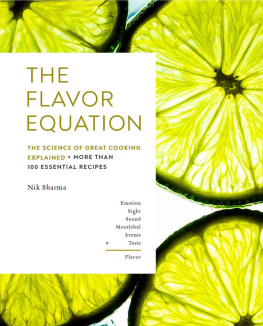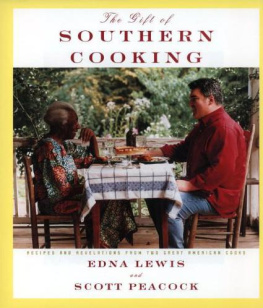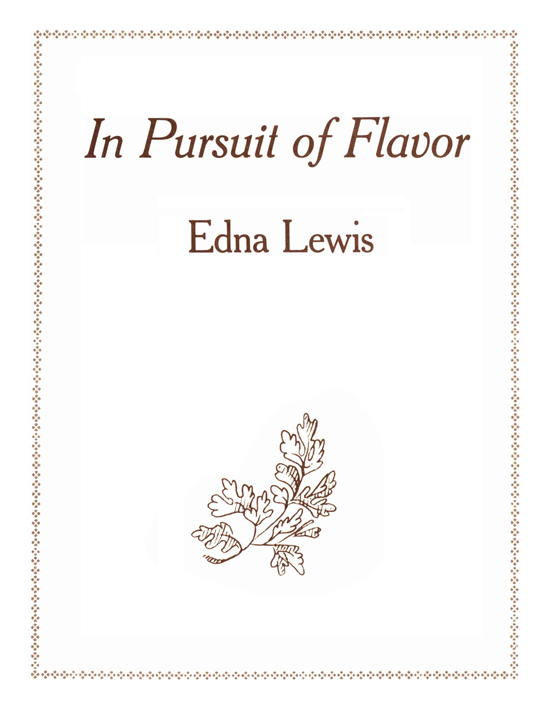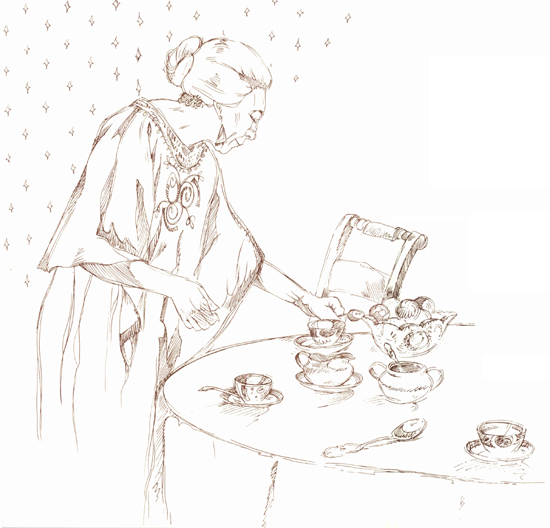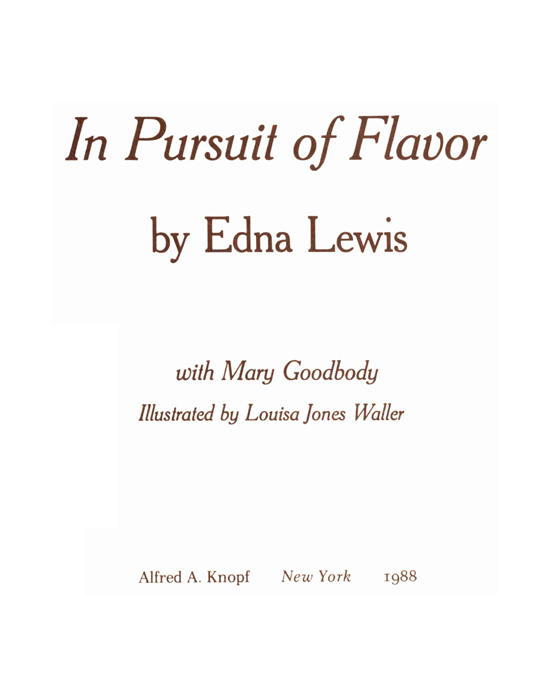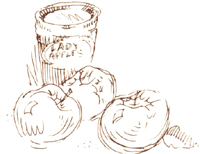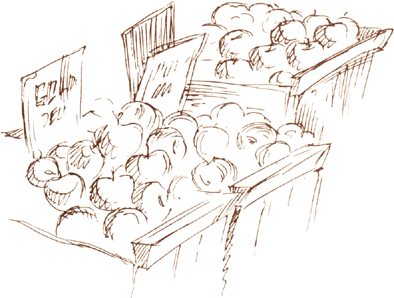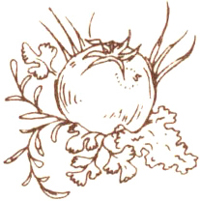
THIS IS A BORZOI BOOK
PUBLISHED BY ALFRED A. KNOPF, INC.
Copyright 1988 by Edna Lewis
Illustrations copyright 1988 by Louisa Jones Waller
All rights reserved under International and Pan-American Copyright Conventions. Published in the United States by Alfred A. Knopf, Inc., New York, and simultaneously in Canada by Random House of Canada Limited, Toronto. Distributed by Random House, Inc., New York.
Library of Congress Cataloging-in-Publication Data
Lewis, Edna.
In pursuit of flavor.
Includes index.
I. Cookery Virginia. 2. Cookery, American Southern style. I. Goodbody, Mary. II. Title.
TX715.L66835 1988 641.5975 88-45215
eBook ISBN: 9780385350822
Hardcover ISBN: 9780394542713
v3.1
Contents
Introduction
I learned about cooking and flavor as a child, watching my mother prepare food in our kitchen in Virginia. She took great care with the food she fed her large family and our assorted guests and I suppose I just naturally followed her example. In those days, we lived by the seasons, and I quickly discovered that food tastes best when it is naturally ripe and ready to eat.
I grew up in Freetown, a small farming community in Orange County, Virginia, which was founded by my grandfather and his friends shortly after his emancipation from slavery. Living in a rural area gave my mother the chance to cook food soon after it was picked. We also canned and preserved the fruits and vegetables from the gardens and fields. The pickles, relishes, chutneys, jams, and jellies added colorful balance to nearly every meal, their tart or sweet flavors offsetting milder ones.
I feel fortunate to have been raised at a time when the vegetables from the garden, the fruit from the orchard, and the meat from the smokehouse were all good and pure, unadulterated by chemicals and long-life packaging. As a result, I believe I know how food should taste. So now, whether I am experimenting with a new dish or trying to recapture the taste of a simple, old-fashioned dish, I have that memory of good flavor to go by.
There are so many ways to get the best out of vegetables; for instance, combining tomatoes (ripened at home if they are off season) with cymling squash, pumpkin with onion and bacon, cooking sweet potatoes with lemon, and boiling corn in its husk. I always keep a bit of country ham around, the way my mother did, or streak-of-lean, to perk up greens or to use as a complement to any number of dishes. The way you use herbs is important, Ive found; some are better dried than fresh. How you cut them and when you add them to the pot make a difference. Cooking fish fillets or chicken breasts in parchment is a wonderful way to seal in delicate aromas; braising in a clay pot keeps meat moist. Ive worked out a method for making an intense-flavored stock by searing chopped-up bones and flesh together, then cooking them quickly. Bones always give flavor, and I often bake sweet-smelling fish with the bones in, as well as roasting fowl whole, or rabbit, or a suckling pig on occasion, each with its own dressing that sets off the taste of the particular meat. And when it comes to baking there are so many tricks Ive discovered, such as using the right flours, making your own baking powder (to avoid that chemical taste), learning to listen for signs of when a cake is done, using bits of frozen butter for one kind of pie crust, pure leaf lard for another. These are just some of the techniques I have developed to get the best flavor from the foods we find today.
In recent years I have been heartened by the growth of farmers markets all across the country, where farmers can sell their products to city people, who more and more are looking for fresh, organically grown vegetables, fruit, meat, and poultry. I have also witnessed promising changes in the ways supermarkets display and sell food. While I continue to believe that we refrigerate too many things and rely too much on the freezer, knowing when to use modern appliances to your advantage is important to a good cook. Every summer, for instance, I pick or buy as many ripe berries as I can find, certainly more than I can eat. Its no bother to freeze them and very easy to preserve them, which means I have the taste of summer far into the wintera gooseberry sauce for some roast fowl or currants for a pie.
I have noticed that as people get older, theyre apt to complain that food simply does not taste as good as it used to. I dont believe this has to be true, and that is why I have tried, in working out these recipes, to give you all kinds of suggestions to make food taste the way you remember it. For those who are too young to remember, I hope the recipes will be a welcome introduction to good food simply and lovingly prepared. One of the greatest pleasures of my life has been that I have never stopped learning about good cooking and good food. Some of the recipes here are old friends, others are new discoveries. All represent a lifetime spent in the pursuit of good flavor.
1
From the Gardens and Orchards
W HEN I was growing up, we ate only what was ripe and fresh at the moment, which, as the spring and summer passed, changed from week to week. This meant that if you were not quick, you could miss a favorite summer treat and would have to wait all year before you could enjoy that good taste again. Beginning with the first spring thaw, we foraged for wild greens and a little later in the year hunted berries and nuts. We planted the garden carefully so that it produced a steady supply of vegetables during the warm months, and picked fruit from the orchards only when it was ripe and sweet.
In this chapter, I have tried to follow the seasons, beginning in the spring with a recipe for tender green peas and Vidalia onions. You will not find many recipes for fruits and berries herethey appear later in the book when I discuss jams, jellies, preserves, and desserts. What you will find are vegetables with good flavor that I think have stood the test of time or can be cooked so that their true flavor comes through. The recipes bring out these natural flavors, showing off each vegetable to its best advantage: sweet peas, eggplant, tomatoes, green beans, leeks, and other vegetables found in many gardens. None of the recipes calls for underripe (the baby vegetables so popular nowadays) or undercooked vegetables. I dont think you get the true flavor of a vegetable if it is partially cooked. If a vegetable is meant to be eaten raw, then it should be raw, but if not, it should be honestly cooked.





